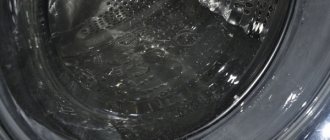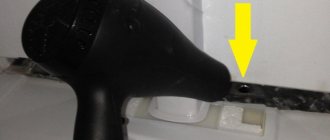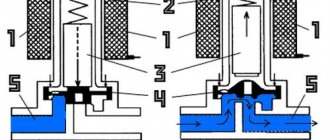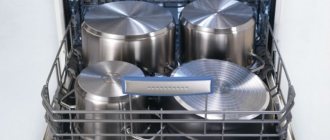“There is water in the dishwasher!” - RemBytTech managers hear almost every day. We always clarify the details. There are two options:
- The dishwasher has completed the cycle, the dishes are clean and dry. But there was water left at the bottom of the equipment after washing.
- The dishwasher has stopped running with water, but the program is not finished. The dishes are wet and perhaps even dirty.
Whatever your case, in this article we will tell you why this could happen, what you can do yourself, and when you need to call a specialist.
How the device works
Water is supplied through the inlet valve - in the dishwasher it is a single type - then it fills the tank to a certain level and is pumped into the rocker arms by a recirculating pump.
Then it flows under pressure, creating circular movements of the rocker, due to which food debris is removed. To thoroughly wash dishes, water is heated using a special element to the maximum temperature set for this model, then it is collected at the bottom of the machine, filtered and supplied for a new cycle of operation.
The water level in the tank is monitored by a special sensor or pressure switch; the solenoid valve is responsible for various additives to the water, softening salt, for example. Powder and rinse aid are added to the working chamber as needed from the dispenser, which is located on the machine door.
The pressure on the sensor comes from two places:
- While collecting water in the main tank.
- Level control in the pan when draining dirty water.
The central board uses the information received in various ways; it is here that signals about any faults that arise are received.
Constant drainage of accumulated water
In this case, check the leakage microswitch. This device is located under the tray. To check it, ring the winding at different positions of the float pressing the mechanism. As a result, an open or short circuit can be detected. If water is found in the pan, they find out how it got there. The leak is repaired and the pan is drained. Then carry out a test run of the dishwasher.
Sometimes the reason for constant drainage of water is improper installation of the drainage hose. If the tank fill level is above the hose exit point, the machine will continuously drain water. To eliminate the problem, reinstall the drainage according to the instructions.
The dishwasher is equipped with a flow sensor to monitor the level of liquid collected. If it malfunctions, the system records more water than is collected in the tank. When a small amount of water is drained, a signal is given that there is not enough liquid to begin the cycle. Therefore, there is a constant intake and release of water. To resolve this problem, check the serviceability of the flow sensor.
What to do if your Bosch dishwasher does not drain water
If your dishwasher stopped before the end of the cycle or did not run it properly, then, depending on the coding on the screen, you can determine the cause of the malfunction. If the words “END”, E24, E25 are displayed on the screen or a faucet is displayed, this means that your Bosch dishwasher is not draining water.
Dishwasher drain system problems
If a Bosch dishwasher does not drain water, this is just a sign of a malfunction, including:
- the drainage system is clogged;
- the siphon or other drainage element is clogged;
- the drain pump has failed;
- control failure occurred.
All these breakdowns are complex, but can be corrected.
My Bosch dishwasher won't drain, what can I do?
You need to start your inspection from the drainage system, that is, from the point where the drain hose is connected. If a clog is found there, then the problem is not in the dishwasher. It is necessary to clean this particular part of the drain system. If not, then you should inspect the equipment itself.
First you need to inspect the filter. It unscrews clockwise. It is removed along with the mesh. It needs to be washed and cleaned with a brush. For this you need to use water, preferably running water. Next, you need to remove the remaining water from the dishwasher manually.
Then the drain pump impeller is checked. To do this, you need to open the lid. It can be screwed on or snapped. It depends on the model. After opening the lid, you need to get rid of all foreign things that could get inside. Check that nothing is blocking the rotation of the impeller.
We put all the parts in place and check the result. If it is missing, this may be due to a faulty drain pump. To fix it, you need to disassemble the machine; to perform such repairs, it is better to contact a specialist.
Enabling forced drain
This operation can only be carried out after checking and cleaning the drain system. To force the machine to forcefully drain water, it is necessary to carry out a number of manipulations, which depend on the model of the machine.
Older Bosch series may have a ratchet switch installed. To open the drain valve, simply rotate it clockwise. In models srv, sgv, etc. you need to reset the programs and close the door. The valve will automatically open. In order to start forced draining for smv, spv, etc. machines, you just need to hold the start button for about 3 seconds.
Repair method after determining the cause of the breakdown
Pinched drain hose
The water just can't come out, it stays in the dishwasher. The drain hose is located on the back of the machine. To remove the kink, the hose must be disconnected and returned to its normal condition. Then restore the original connection. It must be reliable and airtight.
The filter or some drain areas are clogged
Usually the filter becomes clogged with food debris. Manufacturers of dishwashers in the operating instructions must indicate that before installing dishes in the machine, it is necessary to remove all residues from it. To remove the blockage, the filter must be removed and cleaned thoroughly. You can use an ordinary toothbrush, or rinse the part under high pressure running water. The cleaned filter is installed back in its place.
To remove blockages from the dishwasher drain hose, disconnect it from the machine and clean it thoroughly. After making sure the hose is clean, it is returned to its place. Usually the clog is found in the connection to the sewer pipe. To clear the blockage in this area, disconnect the hose and clean the connection point. Re-attaching the hose must ensure a complete seal.
The pump that pumps out water burned out
After completely cleaning all the parts, the dishwasher still does not work. In most cases, this is due to the failure of the booster pump. To remove the pump, you must perform several sequential operations:
- bail out water;
- remove the filter.
- remove the bottom pan;
- disconnect the wires of the “Aqua-stop” indicator;
- release the pump from its mounting, having first removed all hoses.
- The operation of the pump is checked (the impeller should rotate freely).
The pump is considered faulty if there is no rotation. It needs to be replaced.
A multimeter is connected to the free contacts of the pump. Its operating resistance should be 0.2 kOhm. The voltage supplied to the module is checked. If the voltage is too high or completely absent, the pump must be replaced. You can use an analogue or purchase an original part.
The pressure switch is broken
The sensor indicating the water level is called a pressure switch. If a defect occurs in the pressure vessel, the data is greatly distorted. The pressure switch stops signaling to the control module. As a result, the pump stops turning on and the draining stops. To cope with this problem, you need to install a new sensor.
The software module is malfunctioning
It can fail for several reasons:
- short circuit;
- high wear;
- Firmware failure.
Repairing the electrical part of a dishwasher requires a lot of experience and specific knowledge. It is better to entrust such work to professionals. If it is impossible to repair the old module, they will install a new part.
What to do if the dishwasher does not fill with water
It often happens that the dishwasher stops drawing water, and the washing process is postponed for an unknown time. This problem needs to be solved progressively:
- First you need to check the basics: is there water in the tap?
- Then, how tightly the machine door is closed
- Is the shut-off valve on the water pipe closed?
- Is the hose through which water enters the dishwasher pinched?
Eliminating these minor problems may or may not bring a positive result, in which case it will mean that the problem lies in something completely different. For example, the inlet valve filter may be clogged and to clean it you need to unscrew the hose through which water is supplied and find the filter mesh. Then it needs to be thoroughly cleaned and rinsed.
In addition to the problems listed above, more serious ones may also arise:
- Door lock system failure
- Intake valve failure
- Malfunction of the pressure switch - a device for measuring water pressure
- Failure of the Aquastop leakage system
- Malfunction of the control module
To “treat” such problems, you need to involve specialists.
The water does not drain, what could be the reason for this?
There may be several reasons why there is water in the dishwasher. In the first case, we may be talking about a blockage or a kink in the drain hose. You can fix this yourself. But other reasons may be more complex in nature, which is associated with malfunctions of individual elements and systems of the dishwasher. In this case, you simply cannot do without the help of professional craftsmen, since attempts at self-repair can lead to more serious problems.
The machine may not drain completely for the following reasons:
The drain hose in the device is kinked. When the hose connecting the dishwasher to the sewer is pinched or bent, then the water simply has nowhere to escape from the equipment. In such a situation, you need to correct the hose, and then turn on the unit and try to start it again. The filter is clogged. Almost every dishwasher manufacturer strongly recommends rinsing all cutlery to remove food particles before placing it directly into the appliance. However, not everyone follows this rule, thereby causing the filter to become clogged with food particles and other debris. This part is located at the very bottom of the device - it should be carefully removed and cleaned of any blockage that has appeared. After completing this simple procedure, the dishwasher will again be able to cope with its main tasks. The drain system is clogged. All the same food residues can lead to the formation of a plug in the drain hose, as well as in the places where it passes into the sewer. You can also clean these elements yourself.
First of all, the drain hose is very carefully disconnected from the sewer system and immersed in a container prepared in advance. Next you need to activate the drain option
When water flows out of the hose under high pressure, the problem lies in the connection between the sewer and the hose. If the dishwasher does not drain the water completely, then you cannot do without cleaning the hose.
The drain pump is clogged. It is because of this reason that the dishwasher most often does not drain the water. If the design features of the equipment make it possible to independently gain access to the pump, then you can clean it yourself. For these purposes, it will need to be dismantled, thoroughly cleaned and then checked for ease of rotation of the internal impeller. This manipulation should be performed using a pencil or other oblong object. This is due to the fact that most blockages consist of broken dishes, which can seriously injure you.
If, after cleaning all the filters and hoses, the dishwasher still does not drain water or does not turn on at all, then the cause of the malfunction may be a more serious breakdown.
For what other reasons might the water not drain?
There are other reasons why your dishwasher won't drain. However, they are quite serious, and only a professional technician can fix them. These include the following:
- The drain pump is broken. In this case, there can only be one way out - replacing the failed element with a new one.
- The pressure switch (water level sensor) has failed. If such an element of the dishwasher breaks down, then the software module will not be able to obtain information about the internal water pressure. In such a situation, it will also be necessary to replace the faulty part, otherwise the equipment will not work correctly, increasing the likelihood of a flood.
Software module failure. It is this element of the dishwasher that is responsible for analyzing the washing cycles and sending appropriate signals to all other equipment components. If such a system fails, then the entire operation of the device leads to various unpleasant situations. If the unit does not drain the water completely, then it may well be that the entire software module is broken.
Each of the listed reasons for incomplete drainage of water requires its own specific solution, which the video will help you learn about in more detail.
What is it for
The need to remove liquid from the dishwasher may arise due to technical problems with the operation of the device. Before diagnostics and repairs, water is carefully drained so that it does not get on the control module and board. After all, any short circuit poses a threat to human health and life.
Before storing the dishwasher for the winter, water is also drained from the body, because it can harden and rupture the plastic pipes. We are talking about a situation where PMM is used at the dacha only in the summer.
Causes of malfunction
All reasons that may be associated with drainage can be divided into two groups. The first group is associated with all kinds of blockages, and the second suggests a breakdown (malfunction) of some dishwasher unit. We list all the reasons for such a malfunction:
- The drain hose is kinked in some place, so the water does not physically leave the machine. It is enough to straighten it and try to turn on the machine again. Such a trivial problem rarely happens.
- the coarse filter is clogged. Do not neglect the simple rule - before loading, clean the dishes from food residues. Bones, napkins and other debris clog the filter holes, and water will not be able to leave the tank.
- clogged drain areas. Food that has passed through the filter can create a blockage in any part of the drain system, for example, in the pipes, drain hose or pump.
- the pump burned out;
- the pressure switch is faulty;
- The software module is broken.
In Bosch dishwashers from the SRV, SRS or SKF series, in some models the drain problem is detected only after the end of the program. In the middle of the cycle, the machine does not drain the water, but continues to wash dishes only in waste water. But when you open the door, you will see that there is water left in the tank. Some machine models may stop in the middle of the program, and the display will show the word “END” and an indicator in the form of a drawn faucet, which indicates an error during the program.
In Bosch dishwashers from the SMV, SPS or SKS series, if there is a display, fault code E24 will appear, informing about a problem with the drainage. If there is no display in the dishwasher, the lights will light up and a beep will sound and the machine will stop working.
When you can solve the problem yourself
The constant addition and drainage of water from the PMM is not always associated with equipment failure. The following reasons can lead to it, which can be eliminated on your own.
- Incorrect installation of the machine. If the dishwasher drain hose is located too low, the water will drain out of the tank by itself. In this case, the dishwasher will be forced to constantly add water. In models with a display, the water supply error may light up. The optimal height for the drain hose is 50-60 cm from the floor level. This installation of the hose allows you to avoid both self-draining and backflow of water from the sewer. Check for correct installation; if the hose is not at the correct level, correct installation errors.
- One-time failure of the control unit. Perhaps the control board is stuck, causing the dishwasher to fill up and immediately drain water. Try disconnecting the PMM from the power supply for 10-15 minutes. If after turning on the machine starts working normally, the problem was a software failure.
How a dishwasher works
Copying the washing process, water enters the dishwasher bypassing the inlet valve. Single knot. Water fills the tank, touching the level of the lower waterproofing of the door, sometimes heats up, and is pumped through a pipe into the rocker arms by a recirculation pump. A rain of jets washes the dishes, the individual holes are directed to create a torque on the rocker. Movement is happening.
Water is collected by the lower part of the compartment, passes through a cascade of coarse and fine filters, is collected by a settling tank, and is re-supplied according to the program. Once completed, the sump pump releases the dirty stream into the sewer.
The progress of the cycle is monitored by a pressure switch, the heating element heats the water if necessary, the solenoid valve adds softening salt according to the readings of the sensor set to the regulator. Powder and other products are poured into the door dispenser and thrown into the working chamber as the need arises.
Let us add that the pressure switch pressure is taken in two places:
- On the side tank, water is stored during the filling period (preheating).
- The level in the settling tank is controlled during descent.
It is clear that the central board is free to use the information in various ways.
What to do: 6 reasons why water does not drain from the dishwasher
Many people use dishwashers. Some use it every day, while others periodically (when a large amount of dishes accumulates after a feast). No matter how often its owners use it, it may break.
If any problems arise with it, you should pay attention to it. It is necessary to determine the reason why the water does not drain from the dishwasher.
The reasons may be different: blockage, complete or partial breakdown of equipment.
There are six common reasons why water remains in the car:
- Problem with the drain hose;
- Clogged filter;
- Drain clogged;
- Pump burnt out;
- Breakdown of the pressure switch;
- Software module failure.
The second reason for water stagnation in the dishwasher is a clogged cleaning filter. Care must be taken to ensure that food residues do not get into the machine in large quantities. Before loading dishes, you should clean them of food particles. Debris can cause the filter to clog. It needs to be cleaned periodically to avoid problems with water stagnation.
The drain can become clogged with food debris (bread, bones) or paper napkins. You need to carefully monitor the cleanliness of the drain and prevent debris from accumulating in it. If the machine is clogged, you can fix the problem yourself or call a technician.
There may be problems with the pump. In this case, the machine may not drain water. In addition, dishes may not be washed properly
To improve the quality of washing, you should pay attention to the operation of the pump. First you need to check the connection of the dishwasher to the outlet and the settings
If the machine does not work/drains water, but is turned on, then the problem is in the pump. It can burn out completely, which means it needs to be replaced.
How to drain a broken machine
If the equipment is out of order, it will not be possible to drain the water using a special program. Therefore, experts recommend solving the problem this way:
- Turn off the power to the dishwasher and disconnect from communications.
- Open the hopper door.
- Remove the bottom box and waste filter mesh.
- Unscrew the cap of the salt container.
- Prepare a basin, a syringe, and an IV tube.
- Connect one end of the tube to a syringe, and lower the other into a container with regenerating salt.
- Using the syringe, start drawing in water, then remove it and place the free end of the tube into the basin.
In this way you will completely remove water from the ion exchanger. Then the same manipulations must be performed by placing the free end of the tube in a garbage filter. After drying the case from the inside, it will be possible to repair the PMM.
Water in the dishwasher
Reasons for water accumulation in the pan
Why doesn't the water go down the drain? There are several options for the development of events. The simplest ones are a clogged or pinched drain hose. Check whether it is level - maybe it is bent or crushed by some object.
Other reasons for water stagnation in Bosch PMM:
- The drain filter is clogged. Residues of food and small debris fall into the filter during washing. It is advisable to inspect the part for blockages after each cycle.
- The pipe and siphon are clogged. It is necessary to check all parts of the drain.
- The pump is broken or its impeller is jammed. Despite the fact that the dishwasher is equipped with a filter, small particles penetrate deep into the appliance, blocking the operation of the parts.
- The pressure switch is sending incorrect readings. The level sensor is responsible for the amount of water in the hopper. If the pressure switch fails, the board “does not know” that there is water left in the chamber and does not start the pump.
- The control unit is faulty. He controls the operation of all mechanisms in the car. The pump triac may have failed. Then the pump does not receive a signal to turn on and pump out water.
Let's figure out what to do if there is water left in the dishwasher.
Is there a difference in approach depending on the PMM brand?
Manufacturers of modern dishwashers provide a water drain option. To do this, simply press a button on the device control panel.
Stains from dried water in PMM
The situations considered for independent detection and removal of blockages are suitable for equipment of all well-known brands - Bosch, Electrolux, Siemens, Indesit, Hansa, Gorenje, Ariston, Delonghi, Midea, Whirlpool. If the actions fail, it indicates the need to contact the service center specified in the manufacturer’s warranty card.
Forced drainage of water, both for preservation for the winter and for transporting or repairing the dishwasher, is not difficult to carry out. But you should not interfere with the operation of the device without special skills; it is better to entrust diagnostics and troubleshooting to professionals.
Source
Dishwasher does not drain water reasons
The first common cause is clogged filters. To an inexperienced viewer it seems that the gaps are large. In practice, after the coarse step there is a fine one; it is almost impossible for a person without a magnifying glass to see the size of the holes. Unless into the light. It will be more difficult for the owners of Whirlpool, if there are any in Russia. To remove the filter, you will have to disassemble the impeller subsystem by first removing the lower one and undocking the plastic segment of the water supply. Afterwards you can, at the very least, remove the sump cover with filters.
Clean the filter, rinse with running water, try pumping out. You can manually fill the working chamber with a couple of glasses. After turning on, the dishwasher, detecting the presence of water, will try to get rid of it by turning on the pump. The convenience of the equipment, unlike washing equipment, is obvious: the drainage pump is relatively easy to dismantle. It is recommended to remove the lower bezel. You will find access to the pump from the bottom. Perform the necessary operations.
The sump pump is held in place by a pair of screws, in Whirlpool's case it will be Torx. The mechanism resembles what you saw in a washing machine:
- The asynchronous motor is equipped with a pair of coils at the base.
- The rotor is magnetic with several poles.
- The impeller crosses, due to centrifugal acceleration, pushes water to the periphery with a snail.
- Power supply 230 volts.
Bottom impeller
Check if the pump impeller is spinning. It rotates tightly, immediately a quarter (half) turn, jerkily (synchronous motor). The coils ring, the nominal value is about 200 Ohms. It is easy to check the mechanism by connecting to a 230 volt network. We remind you again: the starting mode is individual, indicated in more detail by the unit body. When dismantling the pump, water will probably pour down. There are no emergency measures in dishwashers, the volume is small, inferior to washing machines (devoid of Aquastop).
In most cases, you wind the pump coils by hand. The cost of a new part starts from 300 rubles. Decide for yourself whether it is worth wasting time. The rotor can be adapted for homemade designs in the future.
Dishwasher pressure switch
Water remains in the dishwasher - the pressure switch is to blame. Both pressure selection chambers are made to prevent water and pieces of food from getting inside. Only air. The pressure sampling chamber of the sump is held on by one or two screws and is removed. You will see a small plastic box placed upside down. From under the bottom you will notice: a transparent pressure switch tube approaches the pressure chamber. Using pliers, remove the clamp and dismantle the plastic part.
It happens that food gets clogged inside, the pressure switch readings are incorrect, water is not pumped out, even if the liquid has filled the sump. The tube is sterile clean. Disconnect from the pressure switch side and blow it out. Then you should reliably check the functionality of the pressure (level) sensor. From the side of the pressure switch, the tube clings back. Blow to hear a click.
The click will be heard with a delay of 1 - 2 seconds. Blow, wait. A sound is heard - everything is on its way. The second channel, from the side of the intake tank, works without delay (avoiding excess accumulation). We suspect that for this reason it was necessary to build in two sensors, when logic dictates: you can get by with one. Check the second one: who knows the logic underlying the operation of a dishwasher of the current brand. After checking the mechanical part, it's time to examine the electrical part.
With the tester in our hands and the tubes in our mouths, we begin to make contact calls. If an operation is detected in the form of a drop in resistance to zero, we consider the operation to be complete. There are other reasons why water remains in the dishwasher. The drain hose remains clogged. Check the drain by uncoupling it from the pump.
When to contact a service center
If your dishwasher does not drain, the pump may be faulty. In such situations, it needs to be replaced. The water level sensor - pressure switch - can also become unusable. As a result of a breakdown, the software module receives incorrect information about the internal water pressure. The broken part must be replaced with a new one. If this is not done, the dishwasher will not work correctly.
So why does the dishwasher leave water in it? One should not exclude the possibility of a breakdown of the software module itself. This element controls all processes performed by the dishwasher. The software node, if necessary, gives a signal to certain systems to perform basic functions. If it breaks down, the unit will malfunction. If household appliances stop draining water or do not drain it completely, then it is worth diagnosing the software unit. This can be done at the appropriate service center.
Best answers
Victor STTP Lyashenko:
The norm is 200-400 ml. You have eight times more. This has a detrimental effect on the quality of washing and rinsing. Check the drain hose. He must get out of the car and walk along the floor to the sewer connection point without any ups or downs. And only at the point of connection to the sewer, the end of the drain hose should be raised above the floor level by 40-60 cm. Apparently, after each shutdown of the drain pump, all this water is returned to the machine from the drain hose.
Vladimir Laskov:
Victor is right! The problem is the drain. I suspect that the drain hose from the dishwasher rises smoothly to the drain. But it is better to do the cut-off bend immediately after getting out of the car! IMHO.
aNAHoret:
Victor is right who hooked it up=children
Nedikov Konstantin:
Do you clean the filter inside the bottom of the dishwasher?
proremservice:
If the water is dirty, most likely the problem is in the drainage system proremservice /posudomoechnaya-mashina-bosch-ne-slivaet-vodu
Crack in the tank. What to do?
The machine fills and immediately drains water, why? One of the causes of leakage is damage to the tank itself. Cracks and holes often appear in it. This happens for various reasons. This problem often occurs in cheap dishwashers made in China. Celestial manufacturers, reducing the cost of the finished product, save on everything. Including the quality and quantity of metal used to make the tank.
In Chinese dishwashers, the thickness of the tank wall is negligible. There have been cases when vehicles with a tank wall thickness of 0.12 mm ended up being dismantled. This wall can be broken through with a light blow of an ordinary table knife.
You will not be able to fix a crack or hole on your own. In this case, it is better to change the tank completely.
But if such a part is not on sale, then you can try soldering the wall. This should be done by an experienced craftsman, since the soldering area needs to be additionally reinforced with stiffening ribs.
In fact, it is better not to buy dishwashers from dubious manufacturers.
Water in the dishwasher tray
If you find water in the dishwasher tray, you need to immediately turn off the power to the “home assistant” and begin searching for the cause of the breakdown. Why do you need to urgently turn off the power to the dishwasher? It’s very simple, because we don’t know where the water leaks from. Suddenly a hole has formed in the pipe, which is located next to the relay of some device; a short circuit is of no use to us at all. How to look for the cause of a leak and how to remove water from the pan with your own hands. We will talk about all this in this publication.
For what reason did this happen?
Obviously, water got into the dishwasher tray due to some kind of problem, but here’s what. Some people believe that if water flows into the pan, it means there is a leak somewhere. But with dishwashers it's not that simple. Water may, for example, leave the washing chamber, but let’s not get ahead of ourselves. Let's list the possible causes of the problem.
- The garbage filter is clogged and the washing chamber is overfilled.
- Leak due to damaged pipe.
- Violation of the integrity of the circulation block.
- Washing chamber defect
- Drain pump clogged or damaged.
If the pump is severely clogged, excess pressure may be created inside the part, and water will be squeezed out directly through the body of the part.
Experienced craftsmen say that the reasons for breakdowns usually named offhand can turn out to be empty. Until you open the case, you won't know what's really broken. This is what we will do now.
We eliminate it with our own hands
Don't rush to disassemble your dishwasher. First, let's check for possible defects that are visible from the outside. Let's start with the garbage filter.
- Let's open the dishwasher door wide open.
- Let's roll out the lower basket, which will probably interfere with us, and remove the lower sprinkler.
- Let's take out the garbage filter and the grill that is located nearby.
- Let's wash the removed parts and put them back in place.
If the filter turns out to be clean, then it’s not the problem. You will have to partially disassemble the dishwasher, but first you will need to drain the water. We turn off the PMM and take it out to a place where we can safely work with it. The machine is not too heavy; one pair of male hands will be enough.
To remove water, you need to remove the side walls of the dishwasher. Removing the walls will also help later, when we look for a leak, because almost all the details of the pan will be clearly visible through the resulting openings. Having removed the walls of the case, we lay rags on the floor and tilt the dishwasher on its side. You need to tilt it strongly, almost lay it down, then the water will quickly spill out onto the floor. If you have a large flat container of a suitable size, it is better to use it, since there will be quite a lot of water and it is not worth draining it on a laminate floor.
After removing the water, we check the places where a leak could occur. You will have to feel the pipes, their connections with the pallet parts, in general, everything. You will need to remove the drain pump, disassemble it and check for blockages. If instead of a clog you find a serious breakdown, you need to replace the pump in your dishwasher. You can read about how to do this in the article of the same name on our website.
If the leak cannot be detected, take a large ladle of water, unscrew the garbage filter and pour some water into the hole where the garbage filter was installed, inspect the pan from below. Most likely, water will start dripping in some place and this will reveal the location of the leak.
Do not seal the damaged part. It's better to just replace it with a new one. Otherwise, after some time the leak will resume, and you will have to go into the bowels of the dishwasher again.
So, we figured out what to do if there is water in the dishwasher tray. The most tedious stage is finding a leak, but if you are patient, even the average person will succeed. But if suddenly you cannot find and fix the problem yourself, call a specialist, he will help. Good luck!
How to drain a working dishwasher
If the dishwasher will be stored in an unheated room during cold periods, any remaining working fluid must be removed from it. Proceed as follows:
- Start the drain program and wait until it finishes.
- Then turn off the power to the device.
- Turn off the water supply and remove the hoses.
- Place a rag on the floor to the right of the body.
- Unscrew the waste filter and the lid of the regenerating salt reservoir.
- Carefully place the machine on the right wall to allow any remaining water to drain out.
Next, you need to dry the dishwasher with the door open in a warm and ventilated area. A properly prepared machine will work smoothly next summer season.
Checking the correct operation of a dishwasher that does not receive water
Often, breakdowns occur due to neglect of the manufacturer’s recommendations and rules for using the device.
Therefore, it is important to make sure that you did everything correctly. First, it is recommended to check the presence of water in the tap
One riser is used. Therefore, if there is no water in the tap, then the equipment will not be able to draw liquid. Problems with the water supply can cause temporary malfunctions of the dishwasher.
Be sure to check whether high-quality and correct detergent is used. This can cause serious problems over time. Therefore, you should use only recommended cleaning products.
Make sure the water supply valve is open. It is located at the junction of the hose and the plumbing system. If it is blocked, then liquid collection will not occur.
Bosch dishwasher does not drain water Repair center
Bosch dishwasher won't drain?
Problems with drainage in bosch dishwashers of the srv, sgv, srs, sri, skf series
If problems arise with drainage in dishwashers of these models, usually the dishwasher does not display any errors and continues the washing cycle, but in “old” water. At the end of the wash, water remains at the bottom (above the filter mesh). It may stop during washing, the symbol “END” and “faucet” will light up on the panel. This means that the dishwasher has stopped with an error, the program has been interrupted. All of these options depend on the specific dishwasher model.
Problems with drainage in Bosch dishwashers of the smv, spv, sps, spi, sks series
For Bosch dishwashers of these series, this problem results in the washing program stopping. If there is a display, the dishwasher will display error E24 or error E25. If there is no display, the dishwasher will beep and stop. The control LEDs will light up, usually the “faucet” icon. When you try to start again, the dishwasher will also give an error and will not start. Or it will start if you remove water from the PMM manually, perform one rinse and stop.
Bosch dishwasher does not drain water - do-it-yourself solution to the problem
The first thing you need to do is check the place where the dishwasher drain hose is connected (siphon, drain pipe, etc.) If there are no visible blockages, you can go directly to the dishwasher. The dishwasher filter needs to be disconnected. To do this, turn it counterclockwise and take it out along with the mesh covering the lower part under the sprinkler. We check the filter and wash it under running water, preferably with a brush. If the filter is not clogged (most likely it is), move on to the next step. It is necessary to remove the water that has not drained manually. To do this, you need to scoop out the main volume with a small container, and remove the remainder with a rag or sponge.
Further actions depend on the specific model of the Bosch dishwasher. In the srv, sgv and similar series. You need to unscrew one! Self-tapping screw securing the drain pump cover. See photo. We remove the pump roof and check whether the drain pump impeller rotates easily. If solid food residues get under the impeller, the impeller “wedges” and naturally this leads to a problem with drainage. If there are foreign particles, remove them, reassemble everything in the reverse order and check its functionality.
In Bosch dishwashers of the smv, spv, sms and similar series, you do not need to unscrew anything. We remove the filter along with the mesh, check it, and wash it. Next, we also extract the water manually. At the bottom, the drain pump cover is white and can be removed by manually snapping it or using improvised objects. See photo. We check for the presence of foreign particles, remove them (if any). The pump impeller must rotate freely! It should not cling or wedge! We put everything back together and check it.
If the above steps cannot solve the problem, you need to check the power supply to the drain pump. This procedure involves partial disassembly of the dishwasher. Availability of certain skills and equipment.
How to turn on the forced drain of a Bosch dishwasher?
We cleaned the filters, checked the hoses, let's try:
The Bosch dishwasher drains water at the beginning of any wash cycle and after resetting the wash program.
From simple ones. If the dishwasher is old, it is quite possible that it has a “ratchet” command adapter installed. Simply rotate the switch clockwise. The dishwasher will include various functions (fill valve, circulation pump, etc.) The drain pump is turned on in several positions. Accordingly, drainage should occur.
In models srv, sgv etc. it is necessary to reset the washing program. This is done by simultaneously pressing and holding two program selection buttons (highlighted with the inscription reset), the display will show 0, close the door - forced draining is turned on.
In models smv, spv, etc., hold down the start button for 3 seconds, 0:01 appears on the display, close the door - the machine should drain the water.
https://toorem.ru
The pump hums when draining
Symptoms: when draining water, a noticeable hum is heard, but the drain does not start
The pump can hum either due to the banal clogging of its impeller with debris or foreign objects getting inside, or due to bearing wear.
You can do a simple check and cleaning of the impeller yourself. If the design of the dishwasher makes it relatively easy to reach the drain pump, you can check and clean it yourself. Usually the drain pump is located somewhere at the bottom of the machine next to the drain filter: once you reach it, try turning the impeller with your fingers. If it spins freely, then the problem is something else, but if there are obvious traces of debris, the impeller is jammed or it rotates with difficulty, try cleaning it without removing the pump. Shine a flashlight, try to find a foreign object by touch and remove it. If after your efforts the impeller begins to rotate freely, turn on the drain program and see if the drain works. If it doesn’t help, it’s bad: either the reason for the poor drainage is different, or the breakdown of the drain pump is more serious and you can’t do it without calling a technician.
Main causes of malfunction
Other reasons why water sits in the dishwasher include a number of factors. The most common are:
- excessively high hose position;
- improper functioning of the pump;
- incorrect operation of the liquid level sensor;
- severely clogged filters.
The main and most common reason why water remains in the dishwasher at the bottom or in other places is the high position of the hose. As a rule, the problem is caused by incorrect placement. To troubleshoot a problem, it is often enough to look at the instructions and eliminate the defect. It is not difficult to correctly connect the drainage and water supply hoses to the device.
How to Prevent Future Drain Problems
To avoid damage, follow these simple rules:
- Install the PMM in accordance with the instructions.
- Clean the filter at least twice a month, and perform a preventative run of the machine without dishes once a month. Don't forget to clean the door seals.
- Remove food residues from dishes.
- Use special detergents and salt to soften the water.
Our tips will help extend the life of your dishwasher for many years. Take care of your equipment, then breakdowns will not be a problem.
Watch the video on the topic:
Source











